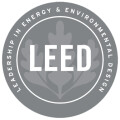Sustainability Report
Certificates

LEED • Platinum • BD+C
V4

WELL • Gold • All
V1
Custom Certificates
WiredScore
Platinum
2022
SmartScore
Platinum
2022
Embedded Carbon
Low Carbon
The project exceeds the Commercial Buildings Energy Consumption Survey (CBECS) Baseline 2003 by 70%, using a highly efficient variable refrigerant flow (VRF) and Dedicated Outdoor Air Systems (DOAS) with heat recovery. Additionally, the project purchased carbon offsets for 100% of the energy consumption for base building.
Carbon Reduction:
A life cycle analysis was performed that indicates the project is 282 kgCO2e/kg. Face brick used throughout the facade has low embodied carbon. A highly efficient structural system significantly also reduced carbon lifecycles, using a high-waisted baker brace with a movable node that was engineered to adapt to Chicago’s changing climate. Innovative bracing solutions reduced lateral loads and material steel quantities.
After carbon analysis of other projects across the firm, the design team determined that ceilings incurred the highest carbon footprint and therefore decided to remove them to reduce the carbon footprint and material waste of the project. A minimal approach to material was employed throughout to minimize material usage and the need for toxic finishes and sealants.
Through extensive analysis of the building’s life cycle and sustainable design program, the design team reduced its enclosure and structure's embodied carbon by 65% when compared to an industry-average commercial office, meeting the 2030 target reduction set by AIA.
Operational Emissions / Energy
Efficient
800 Fulton Market is considered efficient in terms of carbon emissions. The building has an embodied carbon footprint that is 10% lower than typical standards, and it has achieved a LEED Platinum certification, indicating high environmental performance. Additionally, it incorporates advanced mechanical systems designed to enhance energy efficiency, contributing further to its eco-friendly profile.